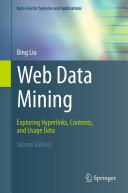
Web Data Mining
Exploring Hyperlinks, Contents, and Usage Data
Web mining aims to discover useful information and knowledge from Web hyperlinks, page contents, and usage data. Although Web mining uses many conventional data mining techniques, it is not purely an application of traditional data mining due to the semi-structured and unstructured nature of the Web data. The field has also developed many of its own algorithms and techniques. Liu has written a comprehensive text on Web mining, which consists of two parts. The first part covers the data mining and machine learning foundations, where all the essential concepts and algorithms of data mining and machine learning are presented. The second part covers the key topics of Web mining, where Web crawling, search, social network analysis, structured data extraction, information integration, opinion mining and sentiment analysis, Web usage mining, query log mining, computational advertising, and recommender systems are all treated both in breadth and in depth. His book thus brings all the related concepts and algorithms together to form an authoritative and coherent text. The book offers a rich blend of theory and practice. It is suitable for students, researchers and practitioners interested in Web mining and data mining both as a learning text and as a reference book. Professors can readily use it for classes on data mining, Web mining, and text mining. Additional teaching materials such as lecture slides, datasets, and implemented algorithms are available online.
- ISBN 13 : 9783642194597
- ISBN 10 : 3642194591
- Judul : Web Data Mining
- Sub Judul : Exploring Hyperlinks, Contents, and Usage Data
- Pengarang : Bing Liu,
- Kategori : Computers
- Penerbit : Springer
- Bahasa : en
- Tahun : 2011
- Halaman : 624
- Google Book : http://books.google.co.id/books?id=gO2-NAEACAAJ&dq=intitle:Data+Mining&hl=&source=gbs_api
-
Ketersediaan :
The book offers a rich blend of theory and practice. It is suitable for students, researchers and practitioners interested in Web mining and data mining both as a learning text and as a reference book.


